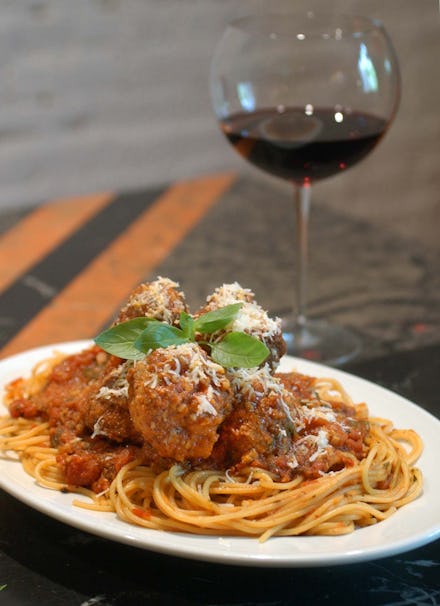World Pasta Day 2016: All the different ways pasta is eaten around the world

October is National Pasta Month and in order to honor all the great pasta in our diverse nation, America will be celebrating World Pasta Day on October 25.
While the Italians are often associated with serving pasta, pasta as we know it actually originated in Asia. In the 2013 book On the Noodle Road: From Beijing to Rome, with Love and Pasta, writer Jen Liu-Liu explores the journey pasta as a food group has taken, from the hand-pulled noodles of ancient China through the Silk Road in what is now Russia, the Middle East and the Mediterranean all the way to Italy and beyond. It's a great read for anyone addicted to carbs, but if you're skipping the library for the supermarket this week, you can still indulge in pasta's multinational history and presence.
America: Spaghetti and Meatballs
Since pasta first made its way to the U.S. via southern Italian immigrants, the pasta enjoyed in the U.S. is most similar to the way pasta is enjoyed in Southern Italy, Luca Donofrio, head pastaio at Eataly New York (dream job alert!) explained over the phone. An Italian-American himself, he grew up with cheese ravioli in tomato sauce and baked ziti, which is not necessarily what you'd find in Italy either.
"You don't see spaghetti and meatballs in Italy, it's a bastardization!" he said.
Americans have added plenty of their own fun flares to pasta, like meatballs on top of spaghetti and Spongebob-shaped macaroni with orange cheese powder. USA!
Italy: Pasta en Brodo, Pasta Shuta, Pasta al Forno
"In terms of how Italians enjoy pasta, it contrasts with how Americans enjoy pasta," Donofrio said. The Italians put pasta into three categories: Pasta en brodo (pasta served in soup), pasta shuta (pasta that is served with a sauce or condiment) and pasta al forno (a baked dish like lasagna).
"Each region had its own tradition of how to eat pasta," Donofrio explained, but as Italy's regions unified, their entire concept of pasta blurred and become "more worldly." The classics still remain however, with Puglia being known for orchiette, which is made with just flour and water and often served with broccoli rabe and regions further north, which traditionally were wealthier, making bright yellow pastas like fettuccine rich in egg yolk. Still, regional dishes are important, Bucatini all'amatriciana is native to the town of Amatrice and Emilia-Romagna is known for rich dishes like agnolotti, a generic term for any stuffed pasta.
Spain: Fideos
"This is one of the most perfect examples I can think of pasta being worldly," Donofrio said. "Fiddelini [which are Italian]. came from fideos, which derives from Arabic fadaz." Three pasta dishes, three nations, one noodle. Fideos are thin, short noodles that may be stirred into soups or prepared as fideua, a dish similar to a paella, but instead of rice, noodles are the starchy base for the baked seafood creation.
Greece: Orzo and Pastitsio
You can see how Greece's proximity to Italy influenced its pasta culture. In Greece, you'll commonly find orzo, a rice-shaped pasta in Avgolemono, which is Greek lemon chicken soup, similar to Italy's en brodo pasta category. The other common method of preparing pasta is as Pastitsio, which can be best conceptualized to Americans as a cross between baked ziti and lasagna: It's a layered, baked ziti dish that uses béchamel and ground pork or lamb and aromatic spices like cinnamon for a seriously fragrant (and heavy) pasta dish. May we recommend a Greek salad on the side to lighten up your meal?
Argentina: Sorrentinos
A history of Italian immigration has left Argentina as an Italian food hotspot. Walk around Buenos Aires and you'll see plenty of fresh pasta shops, pizza parlors and Italian restaurants doling out pasta dishes that rival those in Italy. To the worldwide pasta landscape, Argentinians have contributed sorrentinos, oversized ravioli stuffed with cheese and maybe some meat.
Germany: Spätzle
This thick, starchy noodle is made from egg, water and flour and though it's basic, spätzle can be seriously flavorful and pleasantly chewy. Often served with cheese, under a rich stew or with sauerkraut or cabbage, this hearty German pasta is perfect for winter days when you just want to bulk up, beat the cold and maybe chase down all your carbs with a beer.
Uruguay: Ñoquis
The Spanish translation of Italian gnocchi is quite literally ñoquis, but in Uruguay the noodle-like flour and potato dumplings have a greater significance. On the 29th of each month, Uruguayans traditional eat ñoquis in a tradition dating back to the 10th Century from the custom of Italian immigrants eating homemade pasta on Sundays. Towards the 29th, the end of the month, money would run out and the cheap-to-make gnocchi would be a good staple. Now, on "los 29" or the Día de Ñoquis, ñoquis are eaten both at home and in restaurants, and it's traditional to put a little money under your plate for prosperity.
Israel: Ptitim
What Americans (or Trader Joe's labels) may call Israeli couscous is actually small balls of pasta, referred to as ptitim in Hebrew. Created as a substitute for rice in Ben Gurion's era (1949-1959), Israeli food company Osem credits itself with the invention of couscous-shaped rice. Israeli newspaper Haaretz has also called ptitim "more or less the only unique culinary contribution Israel has made to the world." Traditionally served to children (in the same way that boxed mac and cheese is considered a kids' food but, you know ...), ptitim have recently been seen in gourmet cooking worldwide, though in Israel the minuscule pasta balls are most likely to be seen on the side of a defrosted chicken cutlet the shape of a dinosaur.